CON 216 Exam 2: Analysis of Contractual Disputes and Resolutions
VerifiedAdded on 2019/09/19
|6
|1552
|243
Quiz and Exam
AI Summary
This document presents Exam 2 for CON 216, a course likely related to government contracting or contract law. The exam is divided into three parts: multiple-choice questions, fill-in-the-blank questions, and true-or-false questions, covering topics such as protests, alternative dispute resolution (ADR) methods, equitable adjustments, the Assignment of Claims Act, and relevant legal acts like the Competition in Contracting Act. The fill-in-the-blank section requires knowledge of protest forums, the assignment of claims process, and the steps for filing a protest. The true-or-false section tests understanding of contract law principles, including change orders, burden of proof, and the role of the contracting officer. Finally, a discussion section prompts critical thinking on contractual actions and the differences between government and commercial contracts. This exam assesses the student's comprehension of contract law principles and their application in practical scenarios.
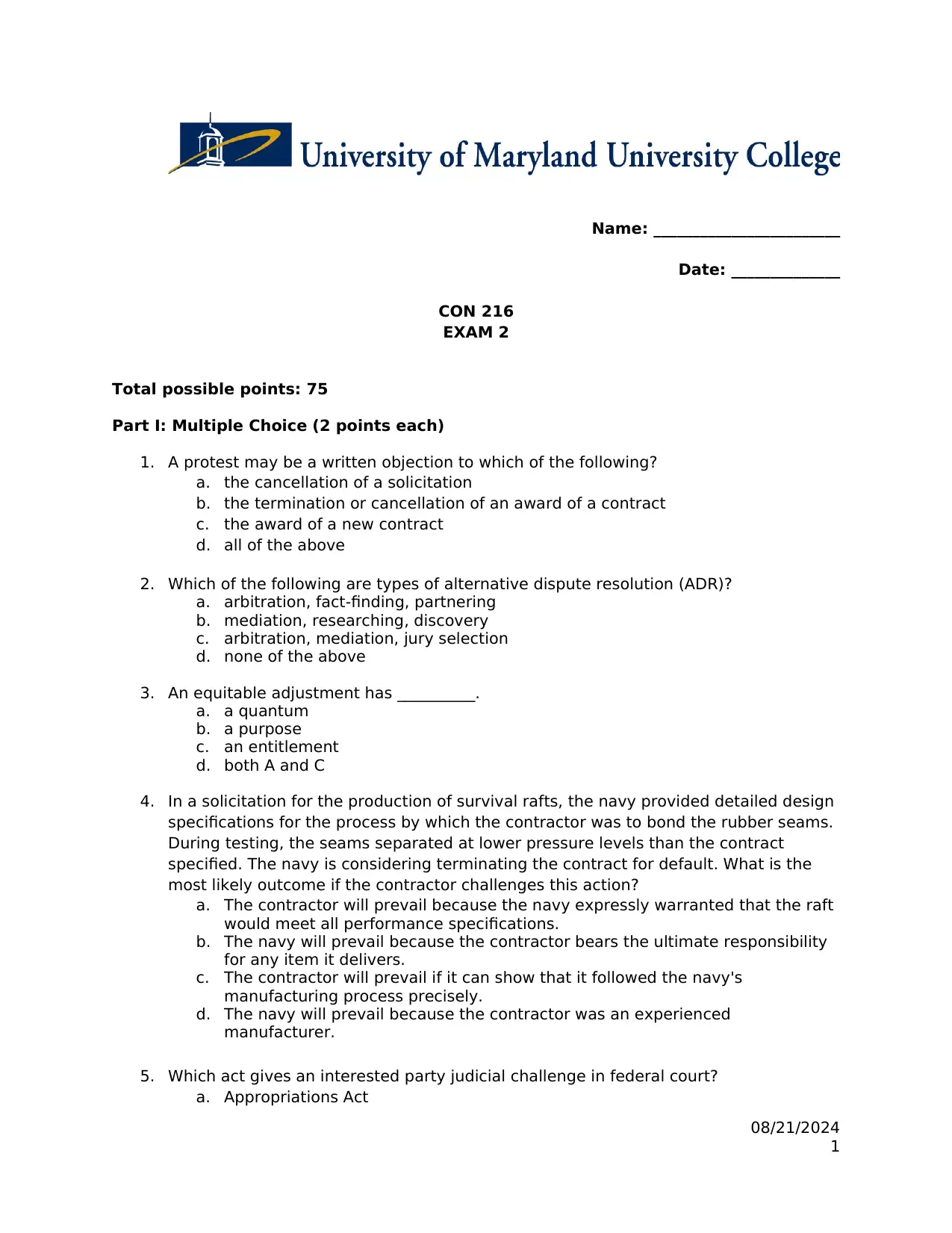
Name: ________________________
Date: ______________
CON 216
EXAM 2
Total possible points: 75
Part I: Multiple Choice (2 points each)
1. A protest may be a written objection to which of the following?
a. the cancellation of a solicitation
b. the termination or cancellation of an award of a contract
c. the award of a new contract
d. all of the above
2. Which of the following are types of alternative dispute resolution (ADR)?
a. arbitration, fact-finding, partnering
b. mediation, researching, discovery
c. arbitration, mediation, jury selection
d. none of the above
3. An equitable adjustment has __________.
a. a quantum
b. a purpose
c. an entitlement
d. both A and C
4. In a solicitation for the production of survival rafts, the navy provided detailed design
specifications for the process by which the contractor was to bond the rubber seams.
During testing, the seams separated at lower pressure levels than the contract
specified. The navy is considering terminating the contract for default. What is the
most likely outcome if the contractor challenges this action?
a. The contractor will prevail because the navy expressly warranted that the raft
would meet all performance specifications.
b. The navy will prevail because the contractor bears the ultimate responsibility
for any item it delivers.
c. The contractor will prevail if it can show that it followed the navy's
manufacturing process precisely.
d. The navy will prevail because the contractor was an experienced
manufacturer.
5. Which act gives an interested party judicial challenge in federal court?
a. Appropriations Act
08/21/2024
1
Date: ______________
CON 216
EXAM 2
Total possible points: 75
Part I: Multiple Choice (2 points each)
1. A protest may be a written objection to which of the following?
a. the cancellation of a solicitation
b. the termination or cancellation of an award of a contract
c. the award of a new contract
d. all of the above
2. Which of the following are types of alternative dispute resolution (ADR)?
a. arbitration, fact-finding, partnering
b. mediation, researching, discovery
c. arbitration, mediation, jury selection
d. none of the above
3. An equitable adjustment has __________.
a. a quantum
b. a purpose
c. an entitlement
d. both A and C
4. In a solicitation for the production of survival rafts, the navy provided detailed design
specifications for the process by which the contractor was to bond the rubber seams.
During testing, the seams separated at lower pressure levels than the contract
specified. The navy is considering terminating the contract for default. What is the
most likely outcome if the contractor challenges this action?
a. The contractor will prevail because the navy expressly warranted that the raft
would meet all performance specifications.
b. The navy will prevail because the contractor bears the ultimate responsibility
for any item it delivers.
c. The contractor will prevail if it can show that it followed the navy's
manufacturing process precisely.
d. The navy will prevail because the contractor was an experienced
manufacturer.
5. Which act gives an interested party judicial challenge in federal court?
a. Appropriations Act
08/21/2024
1
Paraphrase This Document
Need a fresh take? Get an instant paraphrase of this document with our AI Paraphraser
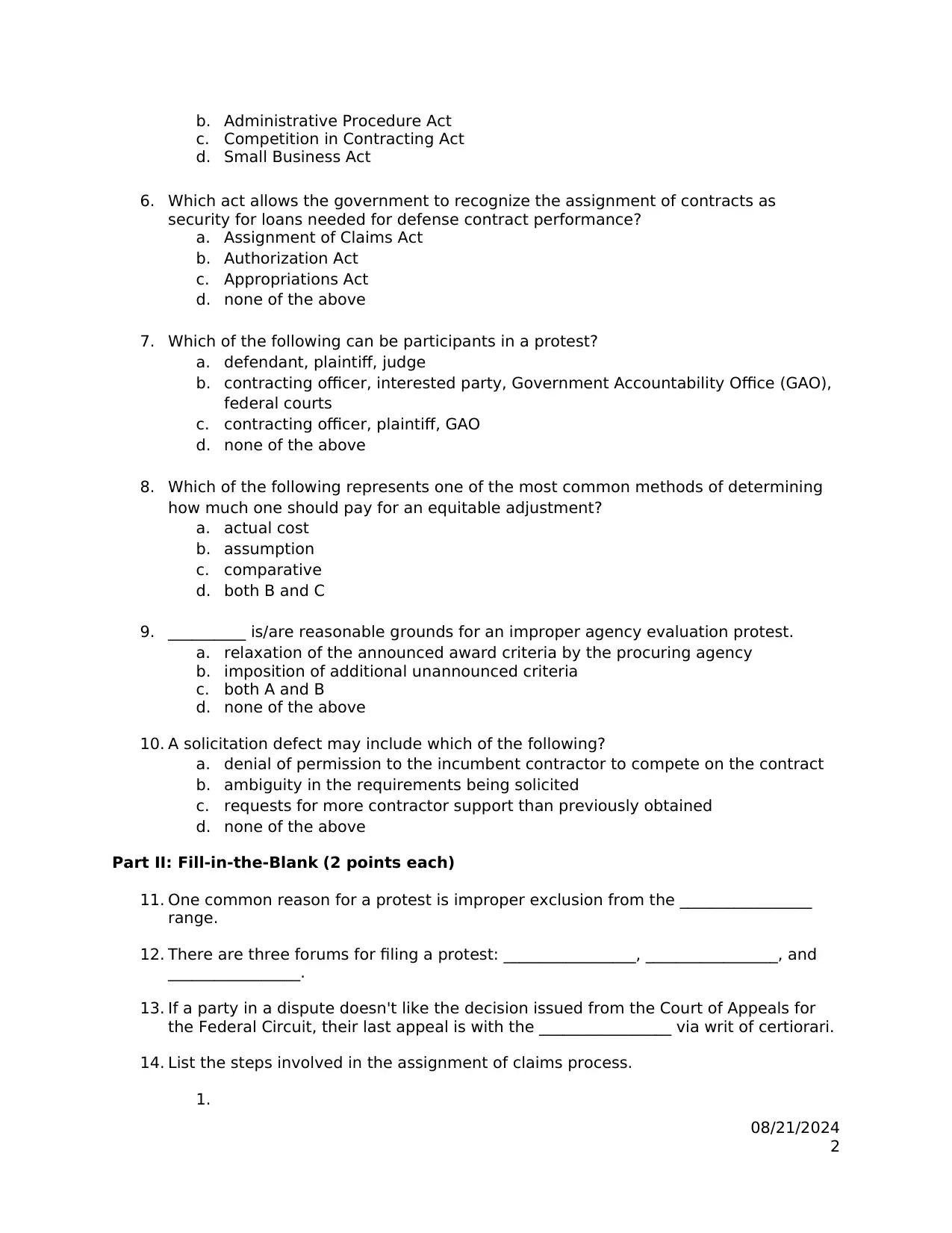
b. Administrative Procedure Act
c. Competition in Contracting Act
d. Small Business Act
6. Which act allows the government to recognize the assignment of contracts as
security for loans needed for defense contract performance?
a. Assignment of Claims Act
b. Authorization Act
c. Appropriations Act
d. none of the above
7. Which of the following can be participants in a protest?
a. defendant, plaintiff, judge
b. contracting officer, interested party, Government Accountability Office (GAO),
federal courts
c. contracting officer, plaintiff, GAO
d. none of the above
8. Which of the following represents one of the most common methods of determining
how much one should pay for an equitable adjustment?
a. actual cost
b. assumption
c. comparative
d. both B and C
9. __________ is/are reasonable grounds for an improper agency evaluation protest.
a. relaxation of the announced award criteria by the procuring agency
b. imposition of additional unannounced criteria
c. both A and B
d. none of the above
10. A solicitation defect may include which of the following?
a. denial of permission to the incumbent contractor to compete on the contract
b. ambiguity in the requirements being solicited
c. requests for more contractor support than previously obtained
d. none of the above
Part II: Fill-in-the-Blank (2 points each)
11. One common reason for a protest is improper exclusion from the _________________
range.
12. There are three forums for filing a protest: _________________, _________________, and
_________________.
13. If a party in a dispute doesn't like the decision issued from the Court of Appeals for
the Federal Circuit, their last appeal is with the _________________ via writ of certiorari.
14. List the steps involved in the assignment of claims process.
1.
08/21/2024
2
c. Competition in Contracting Act
d. Small Business Act
6. Which act allows the government to recognize the assignment of contracts as
security for loans needed for defense contract performance?
a. Assignment of Claims Act
b. Authorization Act
c. Appropriations Act
d. none of the above
7. Which of the following can be participants in a protest?
a. defendant, plaintiff, judge
b. contracting officer, interested party, Government Accountability Office (GAO),
federal courts
c. contracting officer, plaintiff, GAO
d. none of the above
8. Which of the following represents one of the most common methods of determining
how much one should pay for an equitable adjustment?
a. actual cost
b. assumption
c. comparative
d. both B and C
9. __________ is/are reasonable grounds for an improper agency evaluation protest.
a. relaxation of the announced award criteria by the procuring agency
b. imposition of additional unannounced criteria
c. both A and B
d. none of the above
10. A solicitation defect may include which of the following?
a. denial of permission to the incumbent contractor to compete on the contract
b. ambiguity in the requirements being solicited
c. requests for more contractor support than previously obtained
d. none of the above
Part II: Fill-in-the-Blank (2 points each)
11. One common reason for a protest is improper exclusion from the _________________
range.
12. There are three forums for filing a protest: _________________, _________________, and
_________________.
13. If a party in a dispute doesn't like the decision issued from the Court of Appeals for
the Federal Circuit, their last appeal is with the _________________ via writ of certiorari.
14. List the steps involved in the assignment of claims process.
1.
08/21/2024
2
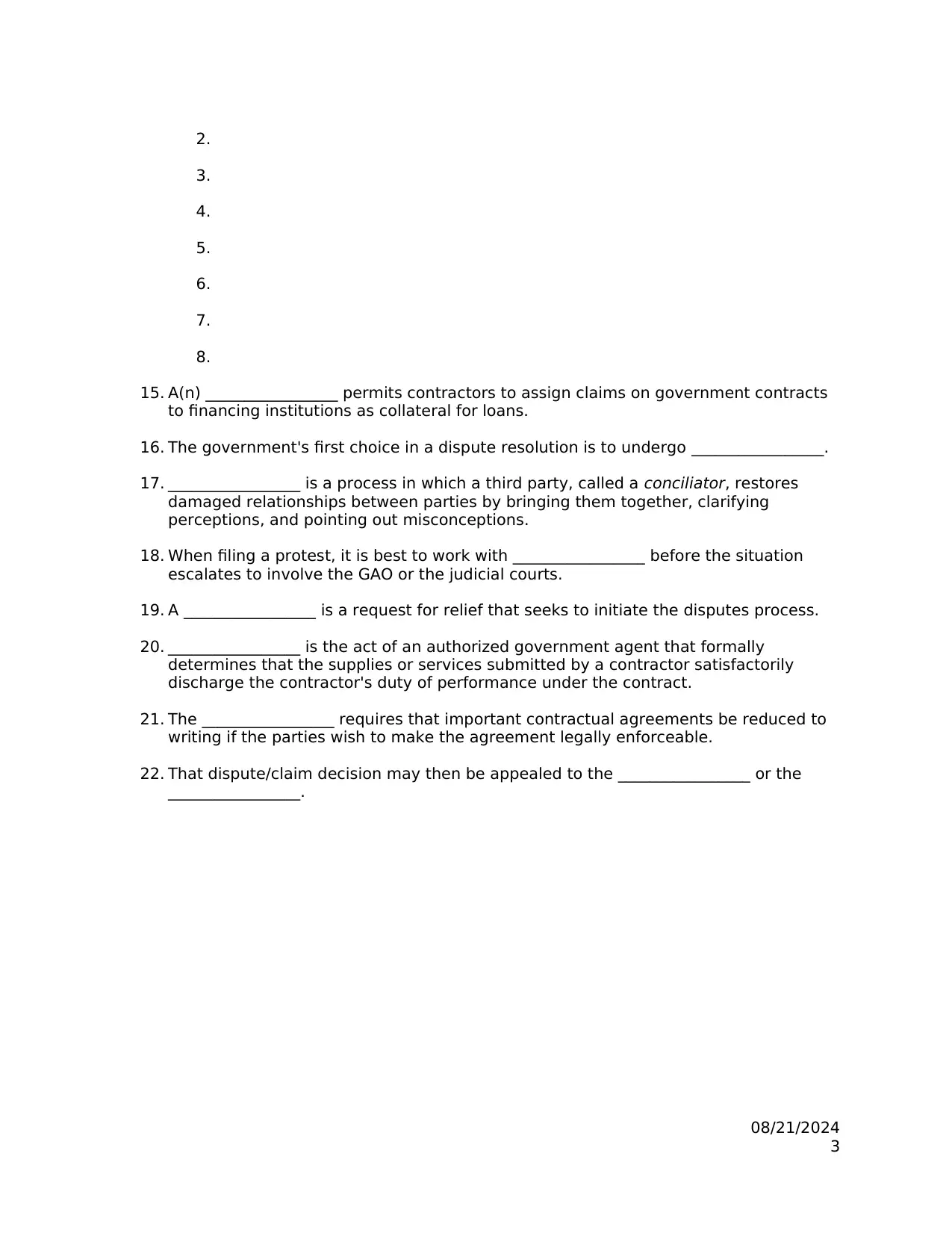
2.
3.
4.
5.
6.
7.
8.
15. A(n) _________________ permits contractors to assign claims on government contracts
to financing institutions as collateral for loans.
16. The government's first choice in a dispute resolution is to undergo _________________.
17. _________________ is a process in which a third party, called a conciliator, restores
damaged relationships between parties by bringing them together, clarifying
perceptions, and pointing out misconceptions.
18. When filing a protest, it is best to work with _________________ before the situation
escalates to involve the GAO or the judicial courts.
19. A _________________ is a request for relief that seeks to initiate the disputes process.
20. _________________ is the act of an authorized government agent that formally
determines that the supplies or services submitted by a contractor satisfactorily
discharge the contractor's duty of performance under the contract.
21. The _________________ requires that important contractual agreements be reduced to
writing if the parties wish to make the agreement legally enforceable.
22. That dispute/claim decision may then be appealed to the _________________ or the
_________________.
08/21/2024
3
3.
4.
5.
6.
7.
8.
15. A(n) _________________ permits contractors to assign claims on government contracts
to financing institutions as collateral for loans.
16. The government's first choice in a dispute resolution is to undergo _________________.
17. _________________ is a process in which a third party, called a conciliator, restores
damaged relationships between parties by bringing them together, clarifying
perceptions, and pointing out misconceptions.
18. When filing a protest, it is best to work with _________________ before the situation
escalates to involve the GAO or the judicial courts.
19. A _________________ is a request for relief that seeks to initiate the disputes process.
20. _________________ is the act of an authorized government agent that formally
determines that the supplies or services submitted by a contractor satisfactorily
discharge the contractor's duty of performance under the contract.
21. The _________________ requires that important contractual agreements be reduced to
writing if the parties wish to make the agreement legally enforceable.
22. That dispute/claim decision may then be appealed to the _________________ or the
_________________.
08/21/2024
3
⊘ This is a preview!⊘
Do you want full access?
Subscribe today to unlock all pages.

Trusted by 1+ million students worldwide
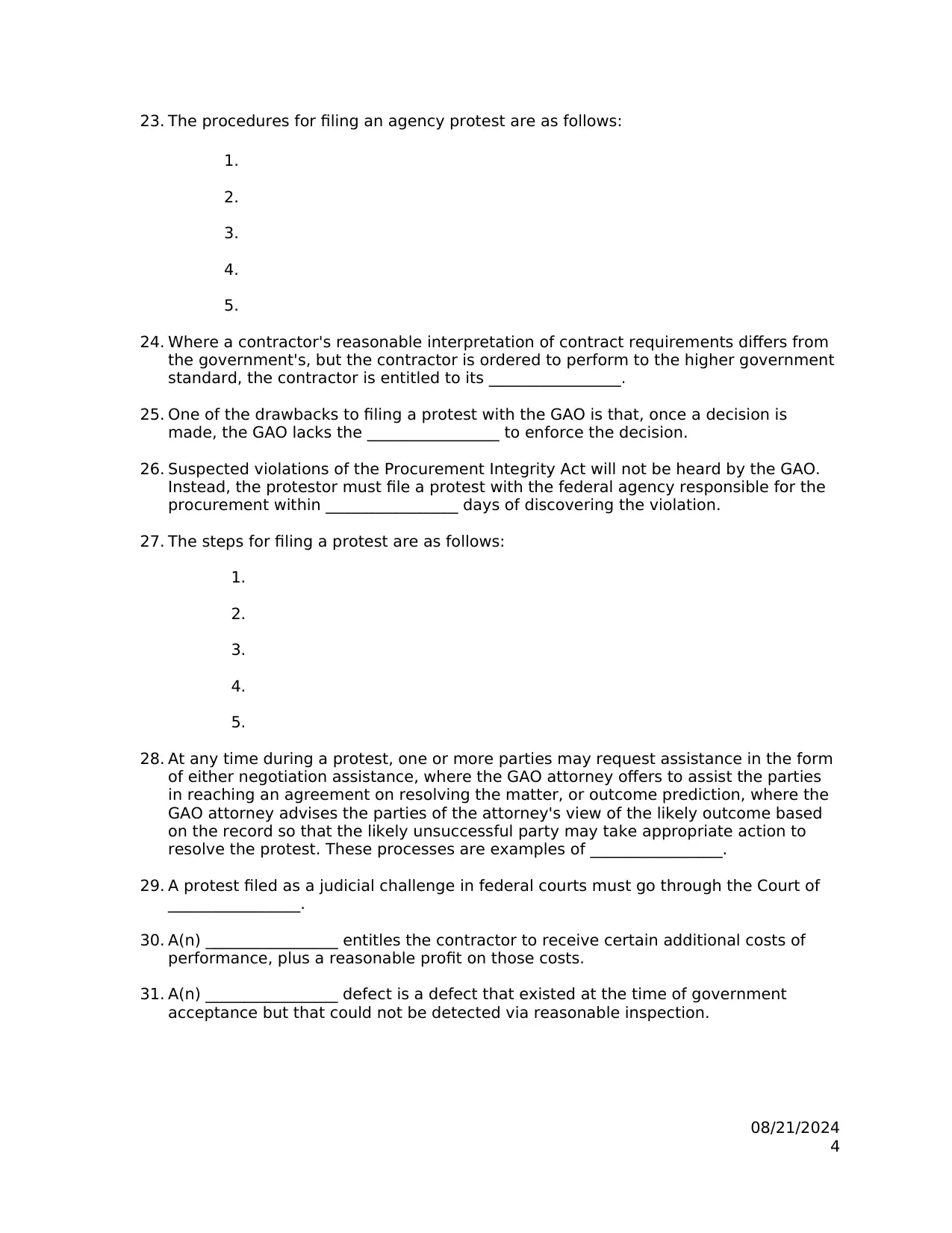
23. The procedures for filing an agency protest are as follows:
1.
2.
3.
4.
5.
24. Where a contractor's reasonable interpretation of contract requirements differs from
the government's, but the contractor is ordered to perform to the higher government
standard, the contractor is entitled to its _________________.
25. One of the drawbacks to filing a protest with the GAO is that, once a decision is
made, the GAO lacks the _________________ to enforce the decision.
26. Suspected violations of the Procurement Integrity Act will not be heard by the GAO.
Instead, the protestor must file a protest with the federal agency responsible for the
procurement within _________________ days of discovering the violation.
27. The steps for filing a protest are as follows:
1.
2.
3.
4.
5.
28. At any time during a protest, one or more parties may request assistance in the form
of either negotiation assistance, where the GAO attorney offers to assist the parties
in reaching an agreement on resolving the matter, or outcome prediction, where the
GAO attorney advises the parties of the attorney's view of the likely outcome based
on the record so that the likely unsuccessful party may take appropriate action to
resolve the protest. These processes are examples of _________________.
29. A protest filed as a judicial challenge in federal courts must go through the Court of
_________________.
30. A(n) _________________ entitles the contractor to receive certain additional costs of
performance, plus a reasonable profit on those costs.
31. A(n) _________________ defect is a defect that existed at the time of government
acceptance but that could not be detected via reasonable inspection.
08/21/2024
4
1.
2.
3.
4.
5.
24. Where a contractor's reasonable interpretation of contract requirements differs from
the government's, but the contractor is ordered to perform to the higher government
standard, the contractor is entitled to its _________________.
25. One of the drawbacks to filing a protest with the GAO is that, once a decision is
made, the GAO lacks the _________________ to enforce the decision.
26. Suspected violations of the Procurement Integrity Act will not be heard by the GAO.
Instead, the protestor must file a protest with the federal agency responsible for the
procurement within _________________ days of discovering the violation.
27. The steps for filing a protest are as follows:
1.
2.
3.
4.
5.
28. At any time during a protest, one or more parties may request assistance in the form
of either negotiation assistance, where the GAO attorney offers to assist the parties
in reaching an agreement on resolving the matter, or outcome prediction, where the
GAO attorney advises the parties of the attorney's view of the likely outcome based
on the record so that the likely unsuccessful party may take appropriate action to
resolve the protest. These processes are examples of _________________.
29. A protest filed as a judicial challenge in federal courts must go through the Court of
_________________.
30. A(n) _________________ entitles the contractor to receive certain additional costs of
performance, plus a reasonable profit on those costs.
31. A(n) _________________ defect is a defect that existed at the time of government
acceptance but that could not be detected via reasonable inspection.
08/21/2024
4
Paraphrase This Document
Need a fresh take? Get an instant paraphrase of this document with our AI Paraphraser
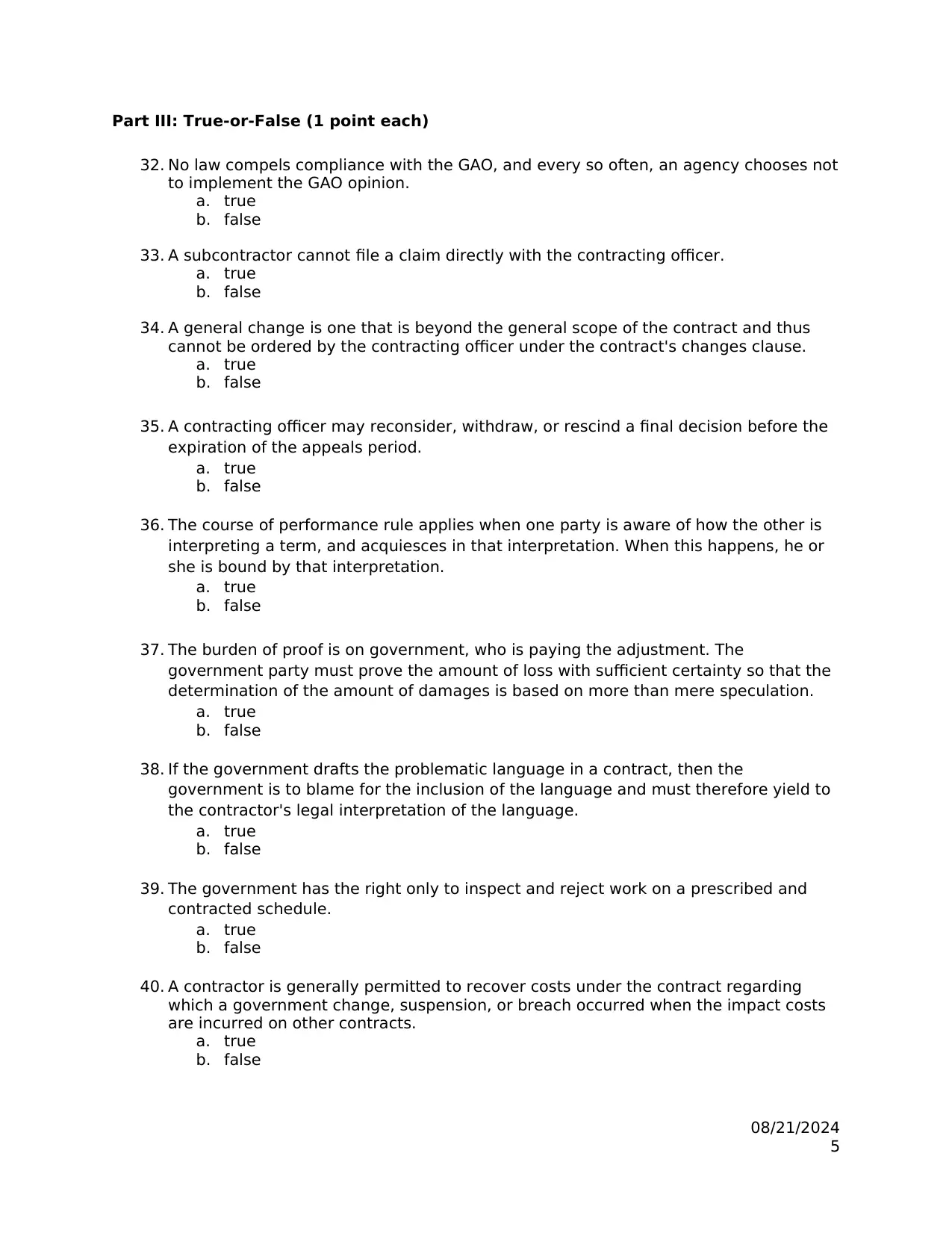
Part III: True-or-False (1 point each)
32. No law compels compliance with the GAO, and every so often, an agency chooses not
to implement the GAO opinion.
a. true
b. false
33. A subcontractor cannot file a claim directly with the contracting officer.
a. true
b. false
34. A general change is one that is beyond the general scope of the contract and thus
cannot be ordered by the contracting officer under the contract's changes clause.
a. true
b. false
35. A contracting officer may reconsider, withdraw, or rescind a final decision before the
expiration of the appeals period.
a. true
b. false
36. The course of performance rule applies when one party is aware of how the other is
interpreting a term, and acquiesces in that interpretation. When this happens, he or
she is bound by that interpretation.
a. true
b. false
37. The burden of proof is on government, who is paying the adjustment. The
government party must prove the amount of loss with sufficient certainty so that the
determination of the amount of damages is based on more than mere speculation.
a. true
b. false
38. If the government drafts the problematic language in a contract, then the
government is to blame for the inclusion of the language and must therefore yield to
the contractor's legal interpretation of the language.
a. true
b. false
39. The government has the right only to inspect and reject work on a prescribed and
contracted schedule.
a. true
b. false
40. A contractor is generally permitted to recover costs under the contract regarding
which a government change, suspension, or breach occurred when the impact costs
are incurred on other contracts.
a. true
b. false
08/21/2024
5
32. No law compels compliance with the GAO, and every so often, an agency chooses not
to implement the GAO opinion.
a. true
b. false
33. A subcontractor cannot file a claim directly with the contracting officer.
a. true
b. false
34. A general change is one that is beyond the general scope of the contract and thus
cannot be ordered by the contracting officer under the contract's changes clause.
a. true
b. false
35. A contracting officer may reconsider, withdraw, or rescind a final decision before the
expiration of the appeals period.
a. true
b. false
36. The course of performance rule applies when one party is aware of how the other is
interpreting a term, and acquiesces in that interpretation. When this happens, he or
she is bound by that interpretation.
a. true
b. false
37. The burden of proof is on government, who is paying the adjustment. The
government party must prove the amount of loss with sufficient certainty so that the
determination of the amount of damages is based on more than mere speculation.
a. true
b. false
38. If the government drafts the problematic language in a contract, then the
government is to blame for the inclusion of the language and must therefore yield to
the contractor's legal interpretation of the language.
a. true
b. false
39. The government has the right only to inspect and reject work on a prescribed and
contracted schedule.
a. true
b. false
40. A contractor is generally permitted to recover costs under the contract regarding
which a government change, suspension, or breach occurred when the impact costs
are incurred on other contracts.
a. true
b. false
08/21/2024
5
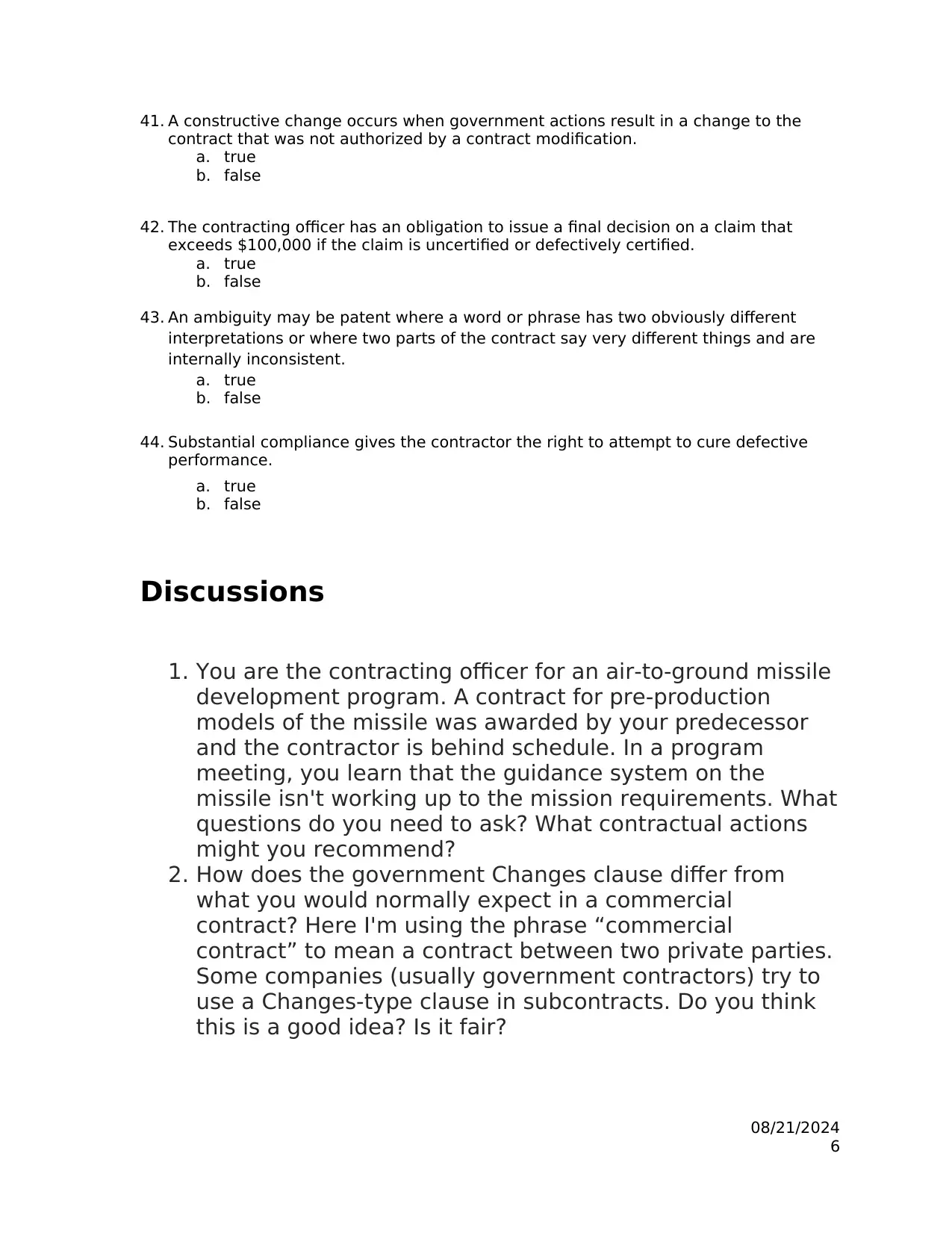
41. A constructive change occurs when government actions result in a change to the
contract that was not authorized by a contract modification.
a. true
b. false
42. The contracting officer has an obligation to issue a final decision on a claim that
exceeds $100,000 if the claim is uncertified or defectively certified.
a. true
b. false
43. An ambiguity may be patent where a word or phrase has two obviously different
interpretations or where two parts of the contract say very different things and are
internally inconsistent.
a. true
b. false
44. Substantial compliance gives the contractor the right to attempt to cure defective
performance.
a. true
b. false
Discussions
1. You are the contracting officer for an air-to-ground missile
development program. A contract for pre-production
models of the missile was awarded by your predecessor
and the contractor is behind schedule. In a program
meeting, you learn that the guidance system on the
missile isn't working up to the mission requirements. What
questions do you need to ask? What contractual actions
might you recommend?
2. How does the government Changes clause differ from
what you would normally expect in a commercial
contract? Here I'm using the phrase “commercial
contract” to mean a contract between two private parties.
Some companies (usually government contractors) try to
use a Changes-type clause in subcontracts. Do you think
this is a good idea? Is it fair?
08/21/2024
6
contract that was not authorized by a contract modification.
a. true
b. false
42. The contracting officer has an obligation to issue a final decision on a claim that
exceeds $100,000 if the claim is uncertified or defectively certified.
a. true
b. false
43. An ambiguity may be patent where a word or phrase has two obviously different
interpretations or where two parts of the contract say very different things and are
internally inconsistent.
a. true
b. false
44. Substantial compliance gives the contractor the right to attempt to cure defective
performance.
a. true
b. false
Discussions
1. You are the contracting officer for an air-to-ground missile
development program. A contract for pre-production
models of the missile was awarded by your predecessor
and the contractor is behind schedule. In a program
meeting, you learn that the guidance system on the
missile isn't working up to the mission requirements. What
questions do you need to ask? What contractual actions
might you recommend?
2. How does the government Changes clause differ from
what you would normally expect in a commercial
contract? Here I'm using the phrase “commercial
contract” to mean a contract between two private parties.
Some companies (usually government contractors) try to
use a Changes-type clause in subcontracts. Do you think
this is a good idea? Is it fair?
08/21/2024
6
⊘ This is a preview!⊘
Do you want full access?
Subscribe today to unlock all pages.

Trusted by 1+ million students worldwide
1 out of 6
Your All-in-One AI-Powered Toolkit for Academic Success.
+13062052269
info@desklib.com
Available 24*7 on WhatsApp / Email
![[object Object]](/_next/static/media/star-bottom.7253800d.svg)
Unlock your academic potential
Copyright © 2020–2025 A2Z Services. All Rights Reserved. Developed and managed by ZUCOL.
